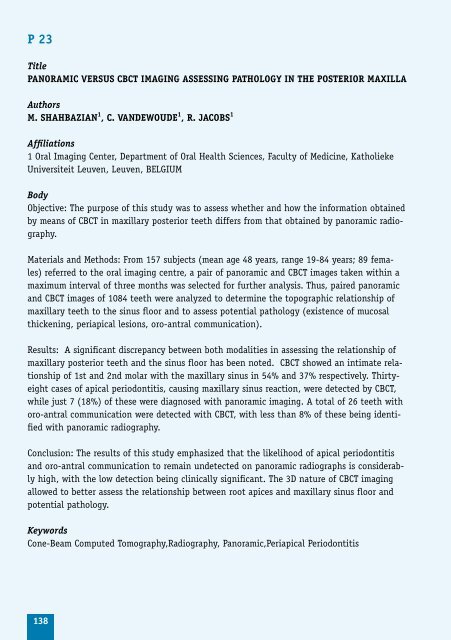Program including abstracts as pdf available here
Program including abstracts as pdf available here
Program including abstracts as pdf available here
Create successful ePaper yourself
Turn your PDF publications into a flip-book with our unique Google optimized e-Paper software.
P 23<br />
Title<br />
PANORAMIC VERSuS CbCT IMAGING ASSESSING PATHOLOGy IN THE POSTERIOR MAXILLA<br />
Authors<br />
M. SHAHbAzIAN 1 , C. VANDEWOuDE 1 , R. JACObS 1<br />
Affiliations<br />
1 Oral Imaging Center, Department of Oral Health Sciences, Faculty of Medicine, Katholieke<br />
Universiteit Leuven, Leuven, BELGIUM<br />
Body<br />
Objective: The purpose of this study w<strong>as</strong> to <strong>as</strong>sess whether and how the information obtained<br />
by means of CBCT in maxillary posterior teeth differs from that obtained by panoramic radiography.<br />
Materials and Methods: From 157 subjects (mean age 48 years, range 19-84 years; 89 females)<br />
referred to the oral imaging centre, a pair of panoramic and CBCT images taken within a<br />
maximum interval of three months w<strong>as</strong> selected for further analysis. Thus, paired panoramic<br />
and CBCT images of 1084 teeth were analyzed to determine the topographic relationship of<br />
maxillary teeth to the sinus floor and to <strong>as</strong>sess potential pathology (existence of mucosal<br />
thickening, periapical lesions, oro-antral communication).<br />
Results: A significant discrepancy between both modalities in <strong>as</strong>sessing the relationship of<br />
maxillary posterior teeth and the sinus floor h<strong>as</strong> been noted. CBCT showed an intimate relationship<br />
of 1st and 2nd molar with the maxillary sinus in 54% and 37% respectively. Thirtyeight<br />
c<strong>as</strong>es of apical periodontitis, causing maxillary sinus reaction, were detected by CBCT,<br />
while just 7 (18%) of these were diagnosed with panoramic imaging. A total of 26 teeth with<br />
oro-antral communication were detected with CBCT, with less than 8% of these being identified<br />
with panoramic radiography.<br />
Conclusion: The results of this study emph<strong>as</strong>ized that the likelihood of apical periodontitis<br />
and oro-antral communication to remain undetected on panoramic radiographs is considerably<br />
high, with the low detection being clinically significant. The 3D nature of CBCT imaging<br />
allowed to better <strong>as</strong>sess the relationship between root apices and maxillary sinus floor and<br />
potential pathology.<br />
Keywords<br />
Cone-Beam Computed Tomography,Radiography, Panoramic,Periapical Periodontitis<br />
138


